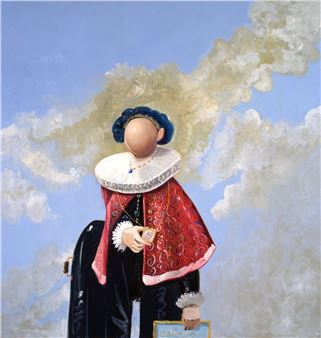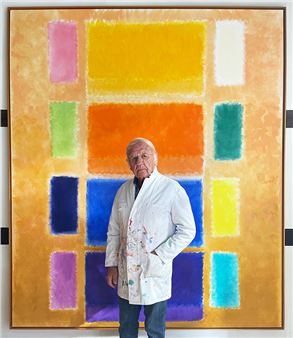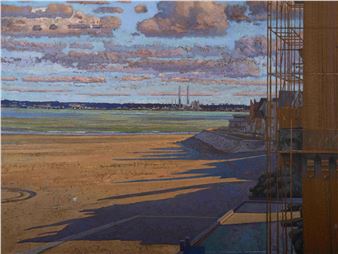Monet / Fromanger: Impression, soleil levant 2019
While on visit as a guest of the Marmottan Museum, Gerard Fromanger stopped in front of a painting by Caillebote, Paris Street, a rainy day. In 1877, the impressionist had depicted two strollers in haussmanвҖҷs Paris. They were at the intersection of the rue de Turin and the rue de Moscou and it comes as no surprise that Fromanger вҖ” widely known as a painter of the street вҖ“was struck by a work of art that celebrated his own favorite subject. The irresistible desire to paint вҖңwith four handsвҖқ, side by side with Caillebotte, to return to a subject that fascinated both of them was manifest. Fromanger made a proposition to the Museum, a proposition that innocently answered a project in gestation at rue Louis Boilly for a long time, to open the museum to the art of its own time.
The Marmatton is not just a museum, it is also a home, appropriated by collectors and descendants of the artists since it went public in 1934. It was home to Jules and Paul Marmatton who founded the institution and also home to Victorine Donop de Monchy who in 1940 gave the Marmatton Impression, soleil levant and ten other signed works by Monet, Renoir, Pissaro, Morisot and Guillaumin. The Monet and Morisot families also made the Marmatton their home, home to the first world-wide collections of these two impresionists. These benefactors were not simply satisfied to offer works of art, they also delegated collections of personal writings, diaries and family portraits. It seems natural therefore that todayвҖҷs painters be able to open the doors of the institution, feel themselves at home and find their own place, a place passed from painter to painter as part of a cultural inheritance.
In this context, the Marmatton has decided to extend invitations to artists twice a year, asking them to do works that resonate with the museumвҖҷs permanent collections. This open invitation to an вҖңunexpected dialogueвҖқ was scheduled to be initiated by Fromanger in 2017. With hindsight, we can see that the ensuing waiting period established the premises of such an encounter. At the end of 2017, while the context of the dialogues remained confidential, Fromanger completed a series of sixteen drawn portraits of yesterdayвҖҷs and todayвҖҷs painters, from Giotto to Bruce Naumann. With such hommage (a Fromanger habit since the 70вҖҷs) Fromanger drew together a community of artists that he called his circle of вҖңFriendsвҖқ, (Amis) the title which he gave to the collection. Caillebotte and Pissarro are not yet included (they will soon be). Monet, however is already part of the group.
Autumn 2018, work begins. Words come before their result is inscribed on a canvas. A first encounter takes place at the artistвҖҷs studio, rue de la Roquette in Paris. Discussion focuses on FromangerвҖҷs ties to Rue de Paris, temps de pluie, by Caillebotte but also with PissaroвҖҷs Boulevard exterieur, effet de neige. Pissaro is a master who Fromanger is determined to include in the project. What is immediately apparent: their shared interests, the subject above all; but their differences or rather each artistвҖҷs singularity is even more manifest and becomes the heart of the ensuing discussion. Depending on the era, the street is represented totally differently. The painter has to take the reality and specificity of his own era into account. In other words the theme is the same, but the language changes. It is the painterвҖҷs task to elaborate such distinctions. Is this art and manner?
To the question, how best to represent the hausmann Paris of the great boulevards painted by the impressionists in the 1870вҖҷs, Fromanger brings us an answer, one hundred years later. In 1970 he devoted his time to a series of works called Boulevard des Italiens. Since then, never stopping, year after year, he has renewed the series and his manner of depicting the Boulevard. What new insights and vision could the street specialist bring to his public?

Recommended for you
While on visit as a guest of the Marmottan Museum, Gerard Fromanger stopped in front of a painting by Caillebote, Paris Street, a rainy day. In 1877, the impressionist had depicted two strollers in haussmanвҖҷs Paris. They were at the intersection of the rue de Turin and the rue de Moscou and it comes as no surprise that Fromanger вҖ” widely known as a painter of the street вҖ“was struck by a work of art that celebrated his own favorite subject. The irresistible desire to paint вҖңwith four handsвҖқ, side by side with Caillebotte, to return to a subject that fascinated both of them was manifest. Fromanger made a proposition to the Museum, a proposition that innocently answered a project in gestation at rue Louis Boilly for a long time, to open the museum to the art of its own time.
The Marmatton is not just a museum, it is also a home, appropriated by collectors and descendants of the artists since it went public in 1934. It was home to Jules and Paul Marmatton who founded the institution and also home to Victorine Donop de Monchy who in 1940 gave the Marmatton Impression, soleil levant and ten other signed works by Monet, Renoir, Pissaro, Morisot and Guillaumin. The Monet and Morisot families also made the Marmatton their home, home to the first world-wide collections of these two impresionists. These benefactors were not simply satisfied to offer works of art, they also delegated collections of personal writings, diaries and family portraits. It seems natural therefore that todayвҖҷs painters be able to open the doors of the institution, feel themselves at home and find their own place, a place passed from painter to painter as part of a cultural inheritance.
In this context, the Marmatton has decided to extend invitations to artists twice a year, asking them to do works that resonate with the museumвҖҷs permanent collections. This open invitation to an вҖңunexpected dialogueвҖқ was scheduled to be initiated by Fromanger in 2017. With hindsight, we can see that the ensuing waiting period established the premises of such an encounter. At the end of 2017, while the context of the dialogues remained confidential, Fromanger completed a series of sixteen drawn portraits of yesterdayвҖҷs and todayвҖҷs painters, from Giotto to Bruce Naumann. With such hommage (a Fromanger habit since the 70вҖҷs) Fromanger drew together a community of artists that he called his circle of вҖңFriendsвҖқ, (Amis) the title which he gave to the collection. Caillebotte and Pissarro are not yet included (they will soon be). Monet, however is already part of the group.
Autumn 2018, work begins. Words come before their result is inscribed on a canvas. A first encounter takes place at the artistвҖҷs studio, rue de la Roquette in Paris. Discussion focuses on FromangerвҖҷs ties to Rue de Paris, temps de pluie, by Caillebotte but also with PissaroвҖҷs Boulevard exterieur, effet de neige. Pissaro is a master who Fromanger is determined to include in the project. What is immediately apparent: their shared interests, the subject above all; but their differences or rather each artistвҖҷs singularity is even more manifest and becomes the heart of the ensuing discussion. Depending on the era, the street is represented totally differently. The painter has to take the reality and specificity of his own era into account. In other words the theme is the same, but the language changes. It is the painterвҖҷs task to elaborate such distinctions. Is this art and manner?
To the question, how best to represent the hausmann Paris of the great boulevards painted by the impressionists in the 1870вҖҷs, Fromanger brings us an answer, one hundred years later. In 1970 he devoted his time to a series of works called Boulevard des Italiens. Since then, never stopping, year after year, he has renewed the series and his manner of depicting the Boulevard. What new insights and vision could the street specialist bring to his public?
Artists on show
Contact details


 ARTISTS
ARTISTS














